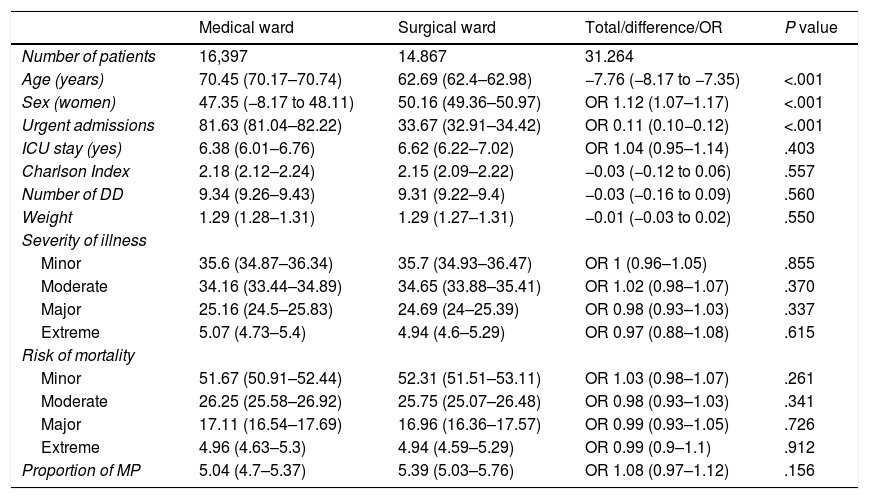Scientific and technological advances are changing medical practice and transforming hospitals, and both the age and comorbidities of hospitalized patients are rapidly increasing. The increasing complexity of these patients and the scant clinical differences between medical and surgical inpatients calls for changes in the organization and delivery of in-hospital care.
Our objective has been to assess differences in age and comorbidity between surgical and medical inpatients.
Materials and methodsRetrospective, observational, descriptive study in patients aged ≥16 years discharged from all medical and surgical services during 2019, except for obstetrics and intensive care. All data were obtained from the hospital's minimum basic data set and analyzed using univariate analysis.
ResultsThe study included 31,264 patients: 16,397 from the medical area and 14,867 from the surgical area. Those in the surgical area were 8 years younger (62.69 years [95% CI 62.4–62.98]), with a slightly higher proportion of women (OR 1.12 [95% CI 1.07–1.17]) compared to the medical area, and fewer non-scheduled admissions (OR 0.11 [95% CI 0.10−0.12]). There were no significant differences in comorbidity burden between study groups.
ConclusionsPatients in the surgical area have a high burden of medical comorbidity, similar to those in the medical area. This information is important for surgeons and anesthetists, and should compel hospitals to change the current organizational model.
El desarrollo científico y tecnológico está cambiando la práctica médica y transformando los hospitales, seleccionando los pacientes que permanecen hospitalizados, los cuales están aumentando su edad y comorbilidad. Son cada vez más complejos médicamente y con menos diferencias clínicas entre los pacientes médicos y quirúrgicos, lo que puede implicar cambios organizativos y asistenciales hospitalarios.
Nuestro objetivo es valorar las diferencias en la edad y comorbilidad existentes entre los pacientes hospitalizados en las áreas médica y quirúrgica.
Materiales y métodosEstudio descriptivo observacional retrospectivo que ha incluido a los pacientes de edad ≥16 años dados de alta durante el año 2.019 de todos los servicios médicos y quirúrgicos, excluidos Obstetricia y Cuidados Intensivos. Los datos se obtuvieron del CMBD del hospital y fueron analizados mediante análisis univariante.
ResultadosFueron incluidos 31.264 pacientes, 16.397 del área médica y 14.867 del área quirúrgica. Los del área quirúrgica son 8 años más jóvenes (62,69 años [IC 95% 62,4–62,98]), con mayor proporción de mujeres (OR 1,12 [IC 95% 1,07–1,17]) y menos ingresos urgentes (OR 0,11 [IC 95% 0,10–0,12]). En las variables relacionadas con la carga de comorbilidad, los resultados entre ambos grupos de pacientes son similares en todas ellas y sin diferencias significativas.
ConclusionesLos enfermos del área quirúrgica tienen una alta carga de comorbilidad médica, similar a los del área médica. Conocer este dato es importante para cirujanos y anestesistas, y abre la puerta a planear alternativas a la organización hospitalaria actual.







